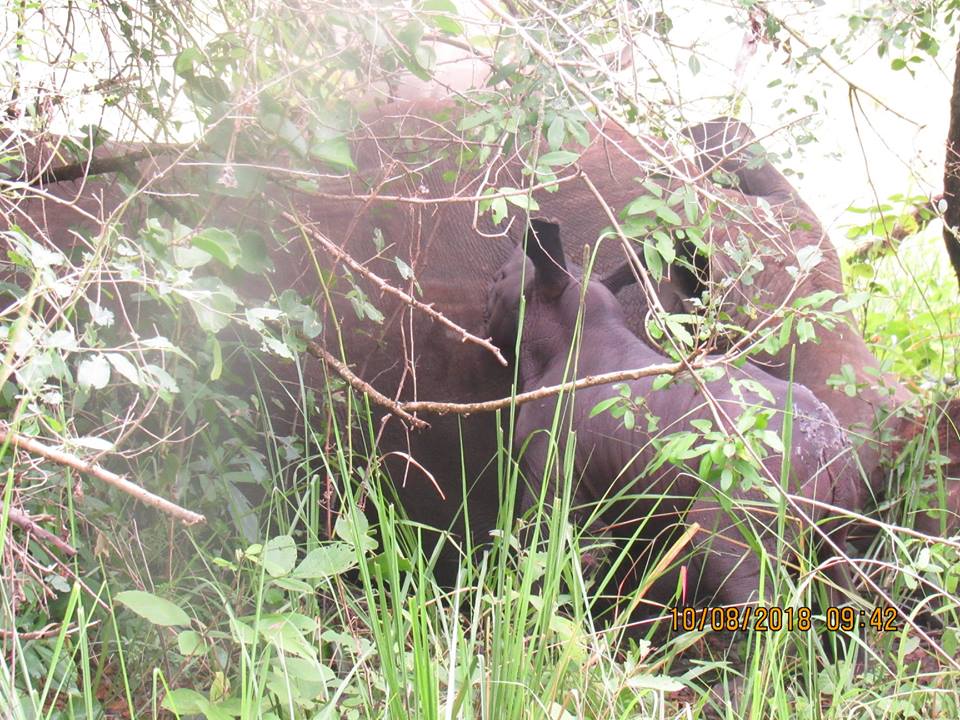2018 has been a year of celebration in Uganda’s conservation fraternity as the country continues to welcome wildlife births!
 Earlier in the year, Adventure Consults must have shared the exciting news of the first baby giraffe in Lake Mburo National Park, in the past few months,we have recorded a number mountain gorilla babies and right now, we are glad to announce the delivery of a healthy baby rhino at the country’s Ziwa Rhino Sanctuary.
Earlier in the year, Adventure Consults must have shared the exciting news of the first baby giraffe in Lake Mburo National Park, in the past few months,we have recorded a number mountain gorilla babies and right now, we are glad to announce the delivery of a healthy baby rhino at the country’s Ziwa Rhino Sanctuary.
The calf, who is yet to be named, was born on Friday 10th August to Mama Bella & proud daddy Moja. This is the 19th rhino calf born on the Sanctuary opened in 1997. The rate at which the rhinos have multiplied to become 24 individuals today is absolutely mindboggling and exciting!
An ecstatic Angie Genade – Executive Director of the Rhino Sanctuary broke the news that “Bella had given birth to another big calf”. This was later confirmed on Saturday through the Rhino reserve’s Facebook page.
“Like the meaning of her name (beautiful Italian), Bella’s babies always look stunning and strong but she is most known to produce the biggest babies on the reserve” Ange mentioned. But it’s not just about big babies for Bella (a commonly calm female). Her gentleness makes her the most visited rhino at the Sanctuary.
The teenage Bella was born in the Kenyan wilderness in 2000, where she was captured and then moved to Uganda in July 2005 at the age of five. She has so far given birth to six babies and five of these are alive today including Augustu who is undoubtedly the biggest of all the rhinos born on the reserve. At only nine years of age, Augustu is often evaded by the older males on the ranch. Could it be because of his size? This guy is known to stubbornly pee around the visitor briefing center, like to show everyone that he is the boss. Or maybe he’s just a big baby in need of some diapers.
The story of rhino conservation in Uganda has been impressively encouraging, from a rather unfortunate state in 1983 when both black and northern white rhinoceros breeds were declared extinct in Uganda, to the first six (6) southern white rhinos which were translocated between 2005 and 2006 from Kenya (four rhinos) and the Disney Animal Kingdom in the USA (2 rhinos); and now to the Twenty-Four (24) rhinos that graze this bushy sanctuary today.
This makes it a total of Twenty-Six (26) rhinos in Uganda when added to the two male and female rhinos at the Uganda Wildlife Education Center, formerly famed the Entebbe Zoo.
Most (if not all) Adventure Consults’ safaris towards the biome-rich Murchison Falls National Park, always offer an opportunity for a detour of the rhino tracking experience. We also offer overnight extensions at the sanctuary which gives travelers an opportunity for night walks and get to see the rare encounters with antelopes as well as the shy nocturnal animals like the leopard & bush babies.
The Rhino Sanctuary is also a delight for bird lovers who can get to spot some of the over 300 bird species that love it here, whether birding on foot along its four birding trails or by canoe in pursuit of the erratic and most loved Shoebill stork.
About White Rhinos
Did you also know that the heaviest part of their body is their head, and that’s probably why they only eat short grass? Quite fascinating, isn’t it?
You may not be able to tell them apart from the black rhinos if you based on just their color. Their name is as a result of a mispronunciation of “Wyd” (an Afrikaans word) meaning wide, which is symbolic of their wide and square-lipped mouths.
With a total population ranging between 19,666 and 21,085 rhinoceroses living in the wild, white rhinos are considered the larger of the two African species (black and white rhinos). But what’s even more fascinating is their agility and ability to run at an average 40 Kmph. You would never want to be in their direction if they began charging!
Sadly, like other rhino species, the white rhino is still endangered because its horn sells like hot cake on the global illicit wildlife trade market mainly for its horn, although the material in its horn (keratin) is the very same substance found in human nails and hair. This leaves us wondering why then they would still be mercilessly killed.
It’s not everywhere that you get to walk in the footsteps of earth’s second largest terrestrial mammal, get in touch with our sales team for amazing Big 5 experiences. More info – www.adventureconsults.com

